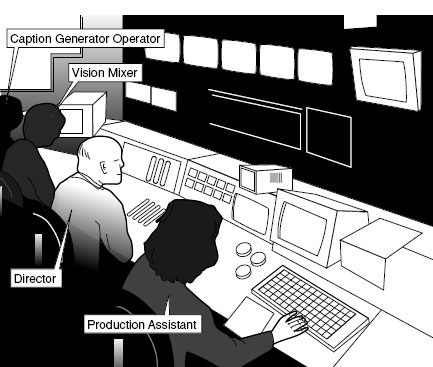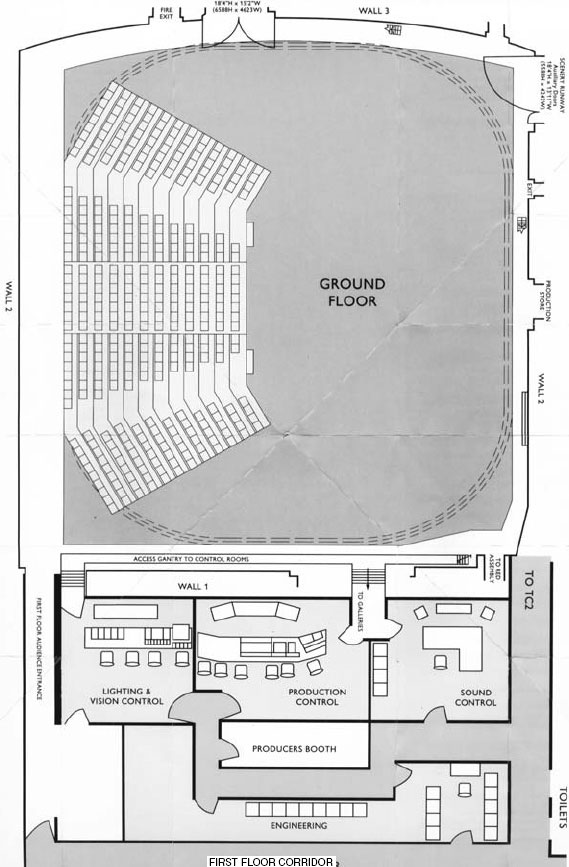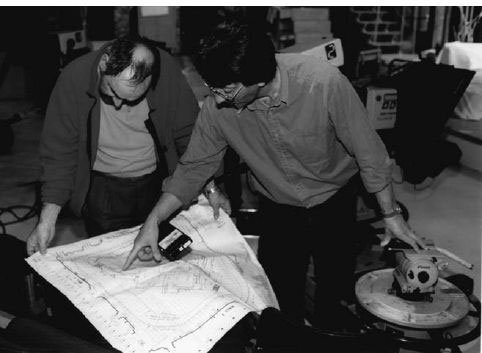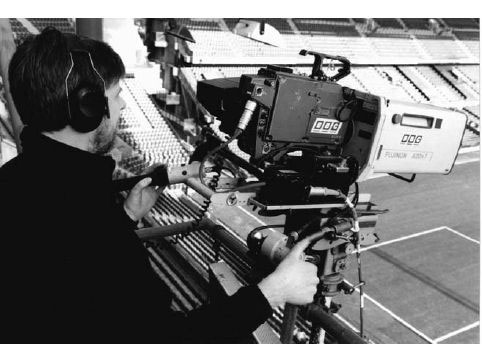Production formats
Having looked at the standard facilities provided by a studio and a location facility we can now examine how a multi-camera programme production uses these resources. There are many types of production formats such as, for example, the studio situation comedy which is usually three or four sets facing an audience rostrum, or sports coverage, where six or more cameras will be positioned to cover all aspects of the contest. All of these programme formats require planning, the dissemination of information to the production team before the event and a method of communicating and coordinating everyone’s contribution on the transmission or recording.
Multi-camera programme making is a team effort and over the years a production procedure has been evolved which maximizes the efficiency of the production group.
The control room staff
Walk into a control room that is engaged in making a programme and there will usually be a programme director with a script or running order on the desk, talking into a microphone to a number of other production personnel. Talkback – the information from the director and the responses from other members of the crew – is the lifeblood of any multi-camera production.
On one side of the director sits the production assistant who works with the director in the preparation of the programme. She times the show, calls the shot numbers and, in some broadcast organizations, will cue telecine and video machines to replay pre-recorded inserts. On the other side of the director is the vision mixer working from a script and under direction, operating the vision mixing panel switching between cameras and all other vision sources.
Also in the control room there may be a technical coordinator who deals with planning and communications, a producer or editor who, depending on programme formats, will oversee content and running order of items. There may also be a caption generator operator who adds text to the pictures (e.g. name superimpositions abbreviated to ‘supers’ or referred to as ‘Astons’).
In the sound control room, the sound supervisor controls the audio and can talk to sound assistants on the studio floor. Possibly there is also a sound assistant playing-in music and effects.
In the lighting and vision control room, the lighting director sits with his/her lighting plot and a console operator at the lighting console and balances the intensity of each lamp in the studio according to the shot and the requirements of the production and groups the lamps for lighting changes and effects if needed. A vision control operator, responsible for the exposure and matching the cameras, sits alongside.
Graphic designers provide electronically generated visual material for the programme as well as two-dimensional graphics.
Control room staff

On the studio floor
The floor manager (FM) relays information from the director during rehearsal and recording/transmission to the front of camera artistes, and liaises and coordinates all other technicians working on the studio floor. The FM may have an assistant floor manager (AFM) and/or a floor assistant (FA) working alongside, depending on the nature and complexity of the programme.
Camera operators wear headsets and can hear the director’s instructions and provide shots of the production according to a pre-rehearsed sequence or, in an as-directed production, according to the role allocated to them.
There may be sound technicians on booms positioning a microphone in relation to artiste movement and the lighting design, or they may be rigging and adjusting personal microphones worn by the programme presenters.
A prompter operator may be tucked away in a corner of the studio controlling the text displayed on a television screen attached to the front of the camera. This allows presenters to look straight at the lens while reading scripted links via a mirror reflection of the text monitor. Depending on the studio, a prompter can also be controlled from the control room or another production area. Scene-hands may be needed to reposition furniture and/or scenery during rehearsal and recording/transmission. Electricians working with the lighting director pre-rig and adjust lamps and electrical equipment according to the lighting plot.
Other members of the production team such as the designer, make-up supervisor, costume design and wardrobe may be on the studio floor, in the control rooms or working in their own specific areas (e.g. make-up). Additional crafts will augment the basic production team depending on the demands of the programme (e.g. a special effects designer).
Technical areas
Usually in a central technical area, engineers operate film and video machines to provide pre-recorded and pre-filmed inserts into the programme (although VTRs may be run by control room staff) and also to record the programme if required. Often a studio or maintenance engineer will be responsible for the serviceability and line-up of all studio equipment.
These are the basic crafts involved with everyday programme making. Depending on the type of programme, there may be many other specialist staff on the production team such as property master, special effects, unit managers, painters, carpenters, etc. On outside broadcast units, riggers drive the OB vehicles, rig cables, lay tracks and track cameras.

In many smaller productions, there is often an overlap of job functions. Multi-skilled is the name given to staff who have the ability to work in more than one craft skill.
Advance planning
Every programme involves some type of advance planning. A two-minute news bulletin, broadcast four or five times a day with a news reader reading straight to camera, will need scheduling of resources and people. It will require the news to be collected and scripted, for the presenter to have access to make-up, the studio facility to be booked and technicians to be scheduled to control the studio facilities. More complex programmes require a longer planning period and a standard procedure to inform and involve all the diverse crafts and skills needed to mount the programme.
Programmes can be roughly divided into those that have a content that has been conceived and devised for television and those with a content that cannot be pre-planned or are events that take place independent of television coverage. Many programmes have a mixture of both types of content. A programme that is planned with the constraints and the facilities that TV can provide (e.g. game shows, soaps, sit-coms, etc.) will have control over every piece of action and the majority of the programme will be prerehearsed before transmission or recording.
Planning for the unpredictable
There are many events covered by TV that contain unpredictable action which cannot be rehearsed such as sport, discussion programmes and other ad-lib activities. No one knows when a goal is going to be scored in a football match or how the run of play will develop, but the TV camera coverage must provide for any of the normal eventualities in a match to be covered. Planning for this requires predicting potential incidents and having cameras assigned to cover such eventualities.
From the initial commissioned idea, some form of script or, possibly to begin with, a rough ‘running order’ of the contents of the programme will be structured. The running order identifies individual sequences in the programme, what the sequences will contain, the vision and sound sources utilised and the duration of each item.
The next stage of the planning involves preparing a script and deciding on design requirements. The flow chart of decisions to be made before recording or transmission depends on the programme format. Scenery needs to be built, scripts written, artistes contracted or programme guests contacted, technical facilities booked and pre-recorded inserts arranged and edited prior to the recording/transmission day. A regular weekly series will have a production planning formula which fits the turnaround time between each programme. It will also have some advanced projects in the planning stage.
Depending on the complexity of the programme, there will be planning meetings and/or recces if it is a location production with engineering managers, lighting directors, camera supervisors, sound supervisors and all other members of the production team who need advance information in order to plan for the programme.
Camera operators checking the floor plan

Shot number system
For many programmes, a camera script will be prepared which breaks down the programme into sections or scenes and then further sub-divides any significant action into separately numbered shots which are assigned to specific cameras. This camera script is usually modified in rehearsal but allows a reference point for all concerned in the production. Each camera operator has his/her own camera cards detailing the shots he/she will be taking.
The production assistant calls each shot number as they are taken during rehearsal and transmission/recording, and the director reminds everyone on talkback of any significant action/event that will occur. The shot number system binds together a whole range of different production activities from lighting changes to equipment repositioning, scenery changes and vision mixing. It is not simply a structure for camera operators.
As-directed coverage
The shot number system provides for the most detailed planning and production precision in, for example, the camera coverage of an orchestral concert where the shots are directly linked to the orchestral score. The score is followed by the director, vision mixer and production assistant and each shot is cut to at a pre-determined point in the score. But multi-camera coverage can use a mixture of other techniques including the following:
![]() Some sequences of the production are shot numbered but other sequences are ‘as-directed’ (i.e. they are not pre-rehearsed). In this method of camera coverage, the director will identify what shots are required on each camera during the transmission or recording, combined with appropriate shots being offered by the camera crew.
Some sequences of the production are shot numbered but other sequences are ‘as-directed’ (i.e. they are not pre-rehearsed). In this method of camera coverage, the director will identify what shots are required on each camera during the transmission or recording, combined with appropriate shots being offered by the camera crew.
![]() Cameras are assigned a role in a structured sequence of shots. For example, a game show where each sequence of the quiz or game will have a defined structure but the order of the shots will depend on the progress of the game, e.g. if ‘A’ answers, Camera 2 will be used. If ‘B’ answers, Camera 3 will be used, etc. This is the most common technique in covering group discussions.
Cameras are assigned a role in a structured sequence of shots. For example, a game show where each sequence of the quiz or game will have a defined structure but the order of the shots will depend on the progress of the game, e.g. if ‘A’ answers, Camera 2 will be used. If ‘B’ answers, Camera 3 will be used, etc. This is the most common technique in covering group discussions.
![]() Cameras are assigned a role (e.g. football coverage where one camera holds a wide, one camera is close, one camera picks up ‘personality’ shots, one camera for slow-motion replay, etc.). With this system, cameras stick to their ‘role’ and do not attempt to offer additional shots until the event has ended.
Cameras are assigned a role (e.g. football coverage where one camera holds a wide, one camera is close, one camera picks up ‘personality’ shots, one camera for slow-motion replay, etc.). With this system, cameras stick to their ‘role’ and do not attempt to offer additional shots until the event has ended.
![]() Cameras are assigned a role for part of the event. For example, a state occasion where a camera position allows unique coverage of a location – a section of a street through which the procession will pass – but is subsequently available to pick up other shots to reflect the atmosphere of the event.
Cameras are assigned a role for part of the event. For example, a state occasion where a camera position allows unique coverage of a location – a section of a street through which the procession will pass – but is subsequently available to pick up other shots to reflect the atmosphere of the event.

![]() An as-directed shoot such as a pop concert where some cameras concentrate on lead singers, instrumentalists, etc. and other cameras are on wide shots and audience.
An as-directed shoot such as a pop concert where some cameras concentrate on lead singers, instrumentalists, etc. and other cameras are on wide shots and audience.
![]() All cameras are individually recorded (isoed) and then edited together in post-production. This technique is more likely to occur using PSCs (portable single cameras).
All cameras are individually recorded (isoed) and then edited together in post-production. This technique is more likely to occur using PSCs (portable single cameras).
